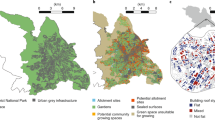Abstract
Urban horticulture, defined as plant production activities that are conducted in a city or suburb that produce horticultural plants that are wholly or partially edible, and which are economically viable, has the potential to reduce CO2 emissions caused by the transportation of produce. Moreover, to increase productivity in limited areas and use limited resources effectively, closed or semi-closed systems (i.e., greenhouses) are considered more advantageous than open systems (i.e., fields) from which resources can easily escape into the surrounding environment. In this paper the significance of urban horticulture in reducing CO2 emissions in the transportation process is discussed with reference to simple case studies. In the context of building or rebuilding greenhouses suitable for urban horticulture, the present situation regarding resource inputs and outputs in greenhouses is compared to that in open fields. The reduction of resource inputs and outputs in greenhouse production is also discussed.




Similar content being viewed by others
References
Greenhouse Gas Inventory Office (2007) The GHGs emissions data of Japan (1990–2005). http://www-gio.nies.go.jp/aboutghg/data/2007/n001_6gas_2007-gioweb_J1.412.xls
Hanan JJ (1998) Greenhouses: advanced technology for protected horticulture. CRC, Boca Raton
Hojo M (2002) Water used for hydroponics (in Japanese). A new manual for hydroponics. Seibundo Shinkosha, Tokyo, pp 148–158
Kozai T, Kubota C (1997) Greenhouse technology for saving the earth in the 21st century. In: Goto E, Kurata K, Hayashi M, Sase S (eds) Plant production in closed ecosystems. Kluwer, Dordrecht, pp 139–152
Ministry of Agriculture, Forestry and Fisheries (2006) Vegetables produced in spring 2006: area planted, quantities harvested, quantities shipped. http://www.maff.go.jp/toukei/sokuhou/data/sakutsuke-haru2006/sakutsuke-haru2006.pdf
Ministry of Agriculture, Forestry and Fisheries (2007a) Vegetables produced in summer/fall 2006: area planted, quantities harvested, quantities shipped. http://www.maff.go.jp/toukei/sokuhou/data/sakutsuke-natsuaki2006/sakutsuke-natsuaki2006.pdf
Ministry of Agriculture, Forestry and Fisheries (2007b) Vegetables produced in fall/winter 2006: area planted, quantities harvested, quantities shipped. http://www.maff.go.jp/toukei/sokuhou/data/sakutsuke-akifuyu2006/sakutsuke-akifuyu2006.pdf
Ministry of Economy, Trade and Industry and Ministry of Land, Infrastructure and Transport (2006) Joint guidelines for methods of calculating CO2 emissions in the logistics field, version 2.0 (in Japanese). http://www.enecho.meti.go.jp/policy/images/060518guideline.pdf
Mori C (2006) The Chemiless Town® project: creating a town that will protect the health of future generations (in Japanese). BIO-City 35:26–27
Nakata T (2003) A study on the volume and transportation distance as to food imports (“food mileage”) and its influence on the environment (in Japanese). J Agric Policy Res 5:45–59
Nakata T (2007) Food mileage: your food changes the world (in Japanese). Nippon-Hyouron-Sha, Tokyo
National Institute for Agro-Environmental Sciences (2003) Life cycle assessment for environmentally sustainable agriculture (in Japanese). National Institute for Agro-Environmental Sciences, Tsukuba
Yano A, Tsuchiya K, Nishi K, Moriyama T, Ide O, Ishizaka A, Toya M (2005a) Development of a power saving greenhouse side window controller driven by photovoltaic energy (in Japanese). J Jpn Soc Agric Mach 67(2):100–110
Yano A, Tsuchiya K, Nishi K, Moriyama T, Ide O, Ishizaka A, Toya M (2005b) Development of a photovoltaic module as a power source for greenhouse environment control devices and a study on its mounting in a greenhouse (in Japanese). J Jpn Soc Agric Mach 67(5):124–127
Yano A, Tsuchiya K, Nishi K, Moriyama T, Ide O (2007) Development of a greenhouse side-ventilation controller driven by photovoltaic energy. Biosyst Eng 96(4):633–641. doi:10.1016/j.biosystemseng.2006.12.012
Acknowledgments
We sincerely thank Professors Toyoki Kozai and Hiroshi Amano for their valuable suggestions.
Author information
Authors and Affiliations
Corresponding author
Rights and permissions
About this article
Cite this article
Ohyama, K., Takagaki, M. & Kurasaka, H. Urban horticulture: its significance to environmental conservation. Sustain Sci 3, 241–247 (2008). https://doi.org/10.1007/s11625-008-0054-0
Received:
Accepted:
Published:
Issue Date:
DOI: https://doi.org/10.1007/s11625-008-0054-0




